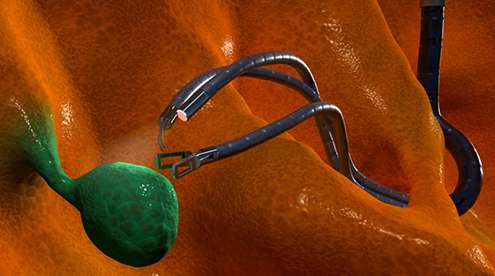'Octopus tentacles' make future operations more flexible

The rigidity of current surgical instruments means it is sometimes only possible to remove part of a brain tumour. Limitations such as these led Professor Paul Breedveld to develop a fundamentally new class of flexible surgical instruments, inspired by the anatomy of octopus tentacles. In his inaugural address on Wednesday 11 December, Prof. Breedveld will include an animation showing how an operation with this new type of instrument will be performed.
Nature follows spectacular design paths that are often very different from human technology, but which lead to elegant and surprisingly smart solutions. The discipline of biomimicry studies nature and tries to copy ideas from it to arrive at new technological discoveries. 'But mere copying also leads to limitations and is not the best way to use biological ingenuity optimally,' explains Prof. Paul Breedveld in his inaugural address as professor at TU Delft.
Octopuses
Breedveld would therefore prefer to talk about bio-inspired research than about biomimicry. He himself is focusing on the development of a fundamentally new class of flexible surgical instruments for minimally invasive surgery (keyhole surgery). 'Using the anatomy of octopus tentacles, we are currently producing the thinnest (diameter of 0.9 and less) and most flexible steerable instruments in the world.'
The tentacles of an octopus are made up of an ingenious composition of muscles which work together in various layers, rings, bundles and packages. Breedveld's early instruments were based on a single ring of steel cables surrounded by coiled springs, whereas the new instruments are based on a so-called dendritic mechanism, with branched extensions. They consist of a flexible stem which ends in a number of manoeuvrable arms. Each arm is made up of a densely structured package of flexible steering elements. The instruments also possess shape memory, therefore they 'know' where we have been.
The queen of surgery
TU Delft plays a leading international role in this scientific-technological field and as such Breedveld sets the bar high, focusing as he does on skull base surgery. 'Due to its level of complexity, skull base surgery is also known as the queen of surgery. If we know how to make good flexible instruments for this type of surgery, we should also be able to do so for the rest,' says Breedveld.
Currently, skull base surgery is still being carried out with rigid instruments. 'This has its limitations,' explains Breedveld. 'The rigidity of the instruments means it is sometimes only possible to remove part of a brain tumour, simply because it cannot be reached. This problem no longer exists with flexible, snakelike instruments.'
'The ultimate goal is to make an advance in surgical practice, whereby complex operations are performed through just a single small incision that can be chosen independent of the location of the area of the operation.'
Steps
Breedveld is working closely on the development of his instruments with doctors and researchers from the AMC (Endoscopic Skull Base Surgery Centre Amsterdam, ESA). 'Doctors will also have to learn how to use this whole new class of instruments. That is one of the reasons why it will be some time before these flexible instruments become universal in surgical practice,' says Breedveld. 'A number of important steps still need to be taken before we reach this stage. Nevertheless, the medical industry is already showing great interest.'


















